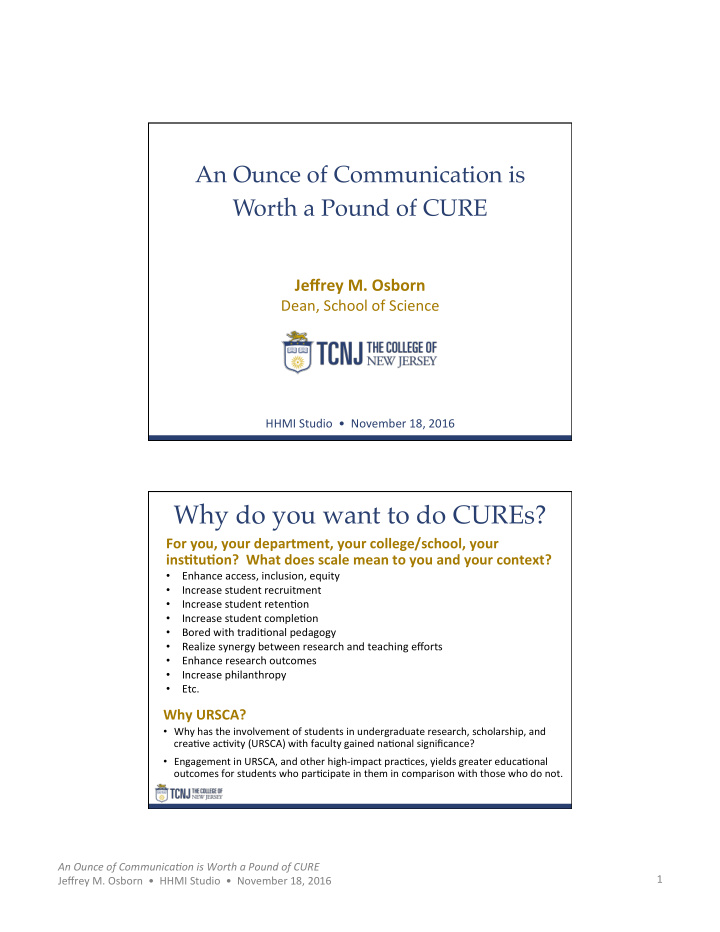



An Ounce of Communication is Worth a Pound of CURE � � Jeffrey M. Osborn Dean, School of Science HHMI Studio • November 18, 2016 Why do you want to do CUREs? For you, your department, your college/school, your ins<tu<on? What does scale mean to you and your context? • Enhance access, inclusion, equity • Increase student recruitment • Increase student retenGon • Increase student compleGon • Bored with tradiGonal pedagogy • Realize synergy between research and teaching efforts • Enhance research outcomes • Increase philanthropy • Etc. Why URSCA? • Why has the involvement of students in undergraduate research, scholarship, and creaGve acGvity (URSCA) with faculty gained naGonal significance? • Engagement in URSCA, and other high-impact pracGces, yields greater educaGonal outcomes for students who parGcipate in them in comparison with those who do not. An Ounce of Communica.on is Worth a Pound of CURE 1 Jeffrey M. Osborn • HHMI Studio • November 18, 2016
Why do you want to do CUREs? Benefits of Undergraduate Research • Student Benefits from URSCA v CogniGve and Intellectual Growth v Professional Growth and Advancement v Personal Growth and Development • Faculty Benefits from URSCA v Research, Scholarly, and CreaGve Outcomes v Mentoring and Teaching v Job SaGsfacGon and Personal Development • Ins<tu<onal Benefits from URSCA v Learning Outcomes v Faculty Quality and Morale v Recruitment and RecogniGon Access, Inclusion, and Equity • The educaGonal gains for students tradiGonally underserved by higher educaGon are even greater when compared to students from majority groups. Osborn & KaruksGs, 2009 Definitions & Campus Culture Shared Understanding & Empathy • Words are important, definiGons are important, but what’s paramount is developing a shared understanding through conversaGon and dialogue. • In this dialogue, listening is cri<cal . What is our perspecGve and posture toward listening? v Listening to develop a shared understanding, or v Listening to win an argument? High-impact Pedagogies • Undergraduate research, scholarship, creaGve work (URSCA) v URSCA; invesGgaGve-, inquiry-, discovery-, problem-based experiences; course-based research experiences; etc. • Civic engagement v Service learning; community-based research; volunteerism, etc. • ‘Independent’ student work v Independent research; independent study; internship; etc. An Ounce of Communica.on is Worth a Pound of CURE 2 Jeffrey M. Osborn • HHMI Studio • November 18, 2016
Definitions & Campus Culture Curricular Integra<on • WriGng across the curriculum analogy • Research across the curriculum v Research-rich v Research-infused v Research-integrated v Research-supporGve • A backward-designed curriculum (it started with the desired outcomes, then designed the collecGon of courses, and then the individual courses) that ver3cally scaffolds research experiences into the courses across all four years that intenGonally create connecGons, build on past learning, and achieve outcomes developmentally. Definitions & Campus Culture Workload: Understanding your Economy • What are the drivers for your insGtuGonal economy? v Credit hour producGon; InstrucGonal producGvity; Contact hours; Course sizes, types, etc.; Student outcomes; Revenue generated (grants, global, conGnuing ed, etc.); Others. • Benchmarking. • There is ogen significant economy to realized in the curriculum. Curriculum: Understanding your Governance Structure and Poli<cal Environment • What are the drivers for your insGtuGonal/departmental curricular decisions? v History; Control levels; Approvals needed; Low threat vs. high threat iniGaGves; Piecemeal vs. comprehensive approach; CoaliGons; Others. An Ounce of Communica.on is Worth a Pound of CURE 3 Jeffrey M. Osborn • HHMI Studio • November 18, 2016
Example Strategies All Data are Local • Most scienGsts (academics) do not take a scienGfic approach to their teaching and pedagogy, and they don’t use data. • Need to counter a sense of ‘excepGonalism.’ • Data on your own program (disaggregated)—not naGonal data—are more likely to convince skepGcs that change is needed. • Anonymity is important when gathering self-assessment data from faculty members. The Value of Teams & Nested Leadership • Leaders – at all levels – maler a great deal. • Leadership teams are incredibly valuable in creaGng and communicaGng change. • The team selected should include mulGple leaders that will provide a nested, or redundant, leadership model. • Each team member needs to be idenGfied, and clearly defined principles and assignments for each person need to be developed. • Put in place structures, with communicaGon strategies. Example Strategies Emphasizing Synergies with other Ins<tu<onal Priori<es • Facilitate the insGtuGonalizaGon of CUREs and URSCA by proacGvely idenGfying linkages between these and other efforts through a broad range of synergisGc connecGons. • The community should not see or perceive the CURE iniGaGve as a ‘project du jour,’ because this leads to ‘iniGaGve faGgue.’ (e.g., service learning, global engagement, learning communiGes, etc.). Investment vs. Expense and ROI • When URSCA and CUREs are viewed as an investment and not as an expense, and these are synergisGcally linked to enrollment management efforts, this investment can lead to increases in student retenGon, success, and compleGon, as well as more revenue. • The return on investment is many-fold. • Major demographic shigs in college-going populaGons across the country. An Ounce of Communica.on is Worth a Pound of CURE 4 Jeffrey M. Osborn • HHMI Studio • November 18, 2016
Example Strategies Time Commitment • Cyclical Stages v Development v Pilot v IniGal implementaGon v Ongoing implementaGon v Periodic review and adjustment • Ongoing Stage v Should not be more work, just different work. • Developmental Stages v Focus on the rewards, improved outcomes, and the fun; not the level of work. Culture • There is no single, right-way to develop the insGtuGonal infrastructure needed to sustain a culture of inclusive excellence, URSCA, CUREs, and student success. • We must incorporate substanGve academic issues, discussion, and reflecGon into the insGtuGonal discourse. v Engagement vs. busyness and over-scheduling v MeeGng agendas v Retreats/workshops • Developing this culture and infrastructure requires broad, grass-roots involvement of the faculty that is bulressed by strong administraGve support. Leadership ma;ers ; it requires leaders – and leadership teams – at all levels. An Ounce of Communica.on is Worth a Pound of CURE 5 Jeffrey M. Osborn • HHMI Studio • November 18, 2016
Recommend
More recommend